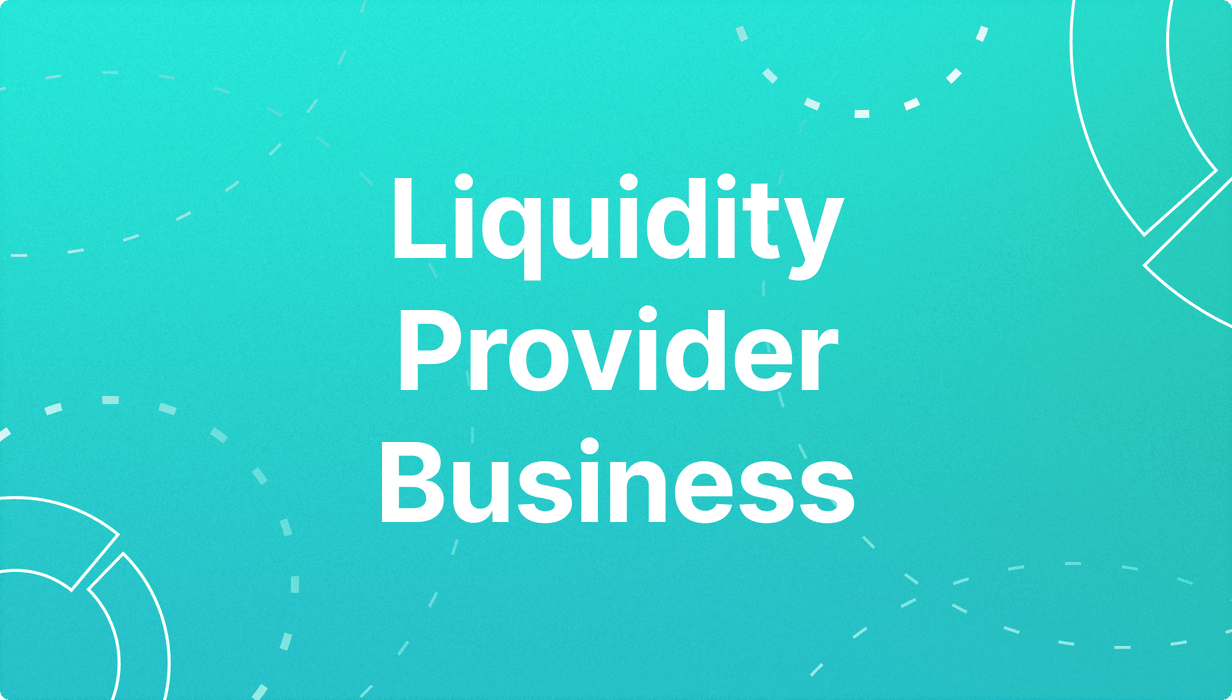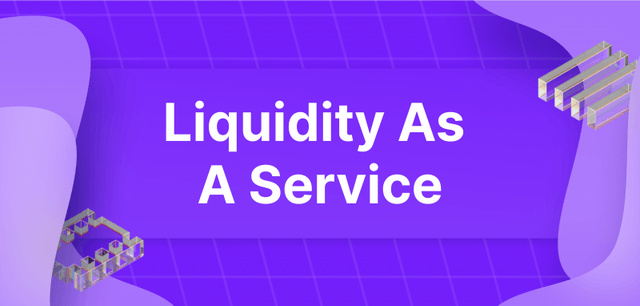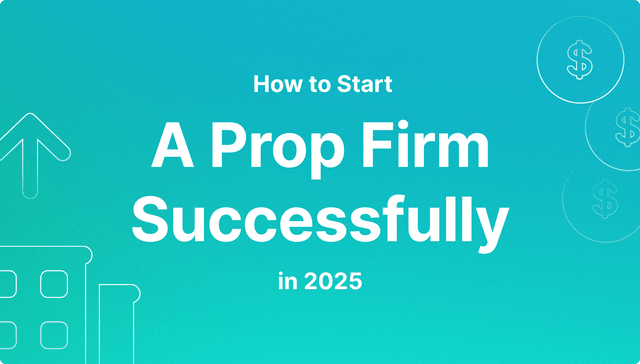How to Start a Liquidity Provider Business in 2025: Complete Guide

The global foreign exchange market now processes over $7.5 trillion in daily turnover, according to the Bank for International Settlements report. At the centre of this massive financial engine are the liquidity providers—the specialised firms that make the market function by supplying deep, reliable order books.
The constant demand for tighter spreads and the expansion into multi-asset trading create a significant business opportunity in this space. Launching a liquidity provider firm, however, is a complex and capital-intensive venture. This guide provides a direct, technical breakdown of the process.

Liquidity providers are fundamental for the success of electronic trading in today's financial market, since they ensure a steady supply of liquidity. This indicator reflects how quickly an instrument can be turned into cash without fluctuating its current price. There are many companies offering liquidity services for any financial market, be it crypto or Forex. But how do they work, and how do they offer liquidity to the market?
What Is Liquidity in Financial Markets, and Why Does It Matter?
In practical terms, liquidity is a measure of how easily an asset can be bought or sold at a stable price. A market is considered "liquid" when there are always enough buyers and sellers to ensure trades can be executed instantly with minimal price impact.
Suppose a trader wants to sell $10 million in a low-volume altcoin. In an illiquid market, that order might push prices down 5–10%, wiping out profits or triggering liquidations. A well-structured LP ensures such a scenario doesn't occur by absorbing volume through aggregated buy/sell flows across multiple venues.
Several macro trends are amplifying the importance of liquidity services:
- Decentralised finance is becoming more institutional: Hedge funds, family offices, and high-frequency traders now demand unified access to both traditional and digital assets.
- The rise of 24/7 markets: Crypto, synthetic indices, and tokenised assets don’t sleep—and brokers need LPs that can handle this.
- More brokers entering the market: Especially in emerging jurisdictions with light regulatory frameworks, creating heightened demand for outsourced liquidity solutions.
This isn’t just crypto— financial markets are shifting more liquidity flows away from traditional banks into non‑bank financial intermediaries globally.
According to the Financial Stability Board’s 2024 report, the non-bank financial intermediation sector grew by 8.5% in 2023—more than twice the pace of banking growth—and now holds nearly half of global financial assets.

That expansion reflects rising trust in non‑bank liquidity channels—and a widening opportunity for new businesses like yours.
What Does a Liquidity Provider Do?
A liquidity provider is a wholesale market participant that offers deep, executable pricing across multiple asset classes to brokers, exchanges, and institutional traders. LPs act as aggregators, not just quoting prices from a single source, but combining data from dozens of banks, non-bank market makers, and exchanges to produce a composite order book.
Critically, liquidity providers are not the same as market makers, though both provide pricing. Market makers typically offer two-sided prices (bid/ask) on a single instrument they control. LPs, by contrast, aggregate liquidity from multiple Tier 1 banks, Prime of Prime brokers, crypto exchanges, and non-bank institutions into one seamless, deep stream.
This stream is then made available to clients via:
- APIs (FIX, REST)
- MT4/MT5 bridges
- White-label terminals
- Direct market access (DMA)
The LP earns revenue based on trading volume—via markups or spread—making this a recurring, scalable business model.
Modern liquidity providers offer:
- Tight spreads across multiple assets
- Deep market depth via aggregation
- High-frequency execution speeds
- Customisable liquidity pools per client
- Real-time risk controls and exposure management
For brokers and exchanges, this translates into better pricing, lower risk, and improved end-user experience—especially important in today’s competitive markets.
Choose a Liquidity Provider You Can Rely On
From Forex and Crypto CFDs to Metals and Indices, our liquidity solutions empower brokerages with seamless execution and consistent availability. The right choice starts here.
How to Start a Liquidity Provider Business
Launching a liquidity provider business is an enterprise-level undertaking that demands a clear, structured approach. This section will guide you through every critical component, beginning with market positioning.
1. Define Your Market Niche and Asset Coverage
The first strategic decision centres on market focus. As a new LP, you must decide:
- Will you offer Forex only, or also crypto, equities, ETFs, or commodities?
- Do you target retail brokers, crypto exchanges, or institutional desks?
- Are you entering as a Prime of Prime, a DeFi-to-CeFi bridge, or a hybrid aggregator?
Multi-asset liquidity is increasingly standard today. In 2024, non-bank LPs serving multi-asset brokers generated over $25.6 billion in trade-related revenue, a 22% increase YoY, according to Greenwich Associates.
2. Obtain the Appropriate Licensing
A strong regulatory foundation is essential for building trust and accessing Tier 1 counterparties. Your choice of jurisdiction depends on your target markets, desired speed of launch, and long-term credibility goals.
Regardless of location, be prepared to submit a detailed business plan and prove capital adequacy. Working with legal advisors experienced in trading regulation is highly recommended.
3. Establish a Robust Technology Infrastructure
Your technology stack is the engine of your business. The core systems include a high-performance aggregation engine, an order matching system, and robust tools for risk management. You will also need powerful APIs (FIX, REST, WebSocket) to provide connectivity for your clients and their various trading platform technologies.
4. Secure Upstream Liquidity Sources
To offer competitive pricing and fast execution, you need strong upstream partners. These include:
- Tier 1 banks – provide deep liquidity and tight spreads, but require high capital and strict compliance.
- Non-bank LPs – such as Prime-of-Primes and crypto providers, offer flexible terms and faster onboarding.
Many new LPs choose to start with a turnkey solution, which comes pre-integrated with multiple liquidity sources. This speeds up launch and reduces technical overhead.
5. Develop Effective Capital and Risk Management Practices
A liquidity provider carries significant market exposure. You must carefully manage leverage, margin calls, counterparty exposure, and profit-and-loss swings across all client flows.
Key risk practices include:
- Real-time exposure tracking to monitor open positions;
- Auto-hedging to reduce unwanted risk;
- Client margin policies to prevent defaults;
- Counterparty risk limits to manage exposure per broker.
Efficient capital utilisation and automated risk controls will help you protect your balance sheet and maintain stable operations.
6. Establish Clear Operational and Legal Frameworks
A scalable LP business needs more than code and capital—it requires bulletproof operational clarity and legal compliance.
Key legal and operational components:
- Client onboarding and KYC/AML: Implement workflow tools and compliance checks at every level, including sanctions screening and document verification.
- Service Level Agreements (SLAs): Define latency guarantees, uptime commitments, and trade execution standards.
- Client contracts: Clearly state margin terms, risk disclosures, execution policy, and dispute procedures.
- Internal policies: Codify escalation procedures, security protocols, and employee access control.
Involving legal counsel early—especially with fintech and multi-jurisdictional experience—helps you avoid regulatory gaps and ensure enforceability across regions.
7. Build Your Go-to-Market Strategy
Define a clear value proposition and position your firm around performance, reliability, or asset coverage. Focus your outreach on brokers, exchanges, and trading platforms through strategic partnerships, industry events, and targeted digital campaigns to accelerate client acquisition and brand recognition.
Start Your Own Liquidity Business
Our turnkey platform bundles technology, regulation, and operational support—plus access to 1,500+ instruments across 10 asset classes—so you can scale your business without complex setup.
Licensing and Regulations for Liquidity Providers
Licensing is a non-negotiable foundation for any liquidity provider business. It builds trust, enables access to top-tier partners, and ensures long-term legal resilience.
Operating without a license limits your ability to work with regulated brokers, Tier 1 banks, and institutional clients. In many jurisdictions, providing liquidity without proper authorisation can lead to fines, blacklisting, or legal shutdowns.
Your licensing strategy should align with your business model and target audience:

Tier-1 (e.g., UK, EU, Singapore): Best for institutional credibility and large-scale operations. Comes with high capital requirements, extensive audits, and long approval timelines (6–12 months).
Mid-tier (e.g., Seychelles, Mauritius): Balance between speed, cost, and access to emerging market brokers. Approval typically takes 2–4 months.
Offshore (e.g., BVI, Cayman Islands): Fastest and cheapest option (1–2 months), ideal for early-stage operations—but may limit your access to institutional partners.
Need Help Getting Licensed?
Our consulting team guides you through the regulatory process, helping you prepare and move faster. With experience holding multiple licenses across jurisdictions, we know what it takes.
The Technology Stack Every Liquidity Provider Needs
Technology is the core of a modern LP's competitive advantage. A successful operation is built on a stack of systems designed for speed, reliability, and scale.
Aggregation and Matching Technology
An aggregation engine is the heart of your system. It consumes price feeds from all your upstream liquidity sources in real-time, selects the best bid and ask prices, and creates a single, unified order book. A powerful matching engine then routes client orders efficiently to ensure minimal latency.
Tools for Risk Management and Reporting
Top-tier providers use sophisticated, real-time tools to manage their market exposure. These systems automatically monitor the firm's net position, hedge unwanted risk, and generate detailed performance analytics. These tools are also critical for meeting regulatory compliance and reporting requirements.
Low-latency Connectivity Infrastructure
In the institutional trading world, speed is measured in microseconds. Low-latency connections between your data centres, your clients, and your upstream liquidity sources are essential. This is often achieved through direct market access (DMA) and co-location of servers in major financial data centres like those in London (LD4) or New York (NY4).
Liquidity Bridge
A liquidity bridge is a crucial piece of software that connects a broker's retail trading platform (like MT4/MT5) to your liquidity aggregation engine. It facilitates the real-time streaming of prices, executes trades, and syncs positions, all while offering the broker risk management features.
Discover the Tools That Power 500+ Brokerages
Explore our complete ecosystem — from liquidity to CRM to trading infrastructure.
Where to Get Liquidity: Top Sources for LPs
The quality of your upstream liquidity directly determines your competitiveness. Your pricing, execution speed, and market depth are all dependent on the partners you connect with.
Connecting with Tier 1 Bank Liquidity Providers
Working directly with Tier 1 banks like JPMorgan or Deutsche Bank provides access to the tightest spreads and deepest liquidity. However, this path has extremely high barriers to entry, including minimum capital requirements of multi-millions of dollars, a proven track record, and stringent technology standards.
For example, working with J.P. Morgan requires $5M+ capital, an audited history, and secure network infrastructure.
Partnering with Non-Bank Liquidity Providers
A more accessible route is to partner with non-bank liquidity providers. This category includes Prime of Prime brokers, large market makers, and crypto-native firms. They offer easier onboarding, more flexible terms, and often superior technology solutions.
B2BROKER is a leading example of a Prime of Prime model. We provide aggregated, multi-asset liquidity from a single margin account, giving LPs and brokers access to deep order books across Forex, crypto, indices, and other markets.
Leveraging a Turnkey Solution
For those who want to start a liquidity provider business without the immense headache and cost of building from scratch, a turnkey solution is the most efficient path. These solutions provide the entire pre-configured technology stack, legal framework, and even access to pre-existing liquidity relationships.
B2BROKER offers a comprehensive liquidity provider turnkey package that includes the aggregation technology, risk management systems, and connectivity needed to launch a fully functional LP business quickly.

Marketing Your Liquidity Provider Business
Once operational, you must market your services to a very specific B2B audience. Your value proposition must be crystal clear: do you offer the tightest spreads, the fastest execution, or the most diverse asset coverage?
Effective strategies include attending major industry conferences (like iFX EXPO), building partnerships with trading technology companies, and publishing expert content on topics like risk management and market structure. Building a reputation for reliability is your most powerful marketing tool.
Launch Faster with Proven Liquidity Provider Infrastructure
The complexity and cost of building a liquidity provider business from the ground up can be prohibitive. Partnering with a specialised technology provider can dramatically accelerate your time-to-market, reduce upfront costs, and mitigate technology risk.
By leveraging a proven, pre-built infrastructure, new LPs can launch with confidence and focus on what matters most: building client relationships and growing their business.
To learn more about a turnkey liquidity provider solution, explore the B2BROKER liquidity offering here.
Have a Question About Your Brokerage Setup?
Our team is here to guide you — whether you're starting out or expanding.
FAQ
- How do I handle liquidity provider integration with existing broker platforms?
Modern liquidity aggregation platforms offer pre-built bridges for MT4/MT5 and standardised APIs (FIX, REST) that can be integrated in days, eliminating months of custom development.
- Can I offer both forex liquidity provider and crypto liquidity services simultaneously?
Yes, but you’ll need separate upstream sources, asset-specific infrastructure, and possibly distinct licenses. Also, with our multi-asset liquidity offering, you can access FX, crypto, and more from a single margin account.
- How long does it take to become a regulated liquidity provider?
Regulatory approval timelines range from 1-3 months in some offshore jurisdictions to 6-12 months in tier-1 financial centres like the UK or EU, not including preparation time.
- What are the main differences between tier 1 and non-bank liquidity providers?
Tier 1 providers offer tighter spreads but require high capital and longer onboarding. Non-bank LPs offer easier access and faster integration.
Recommended articles
Our team will present the solution, demonstrate demo-cases, and provide a commercial offer






